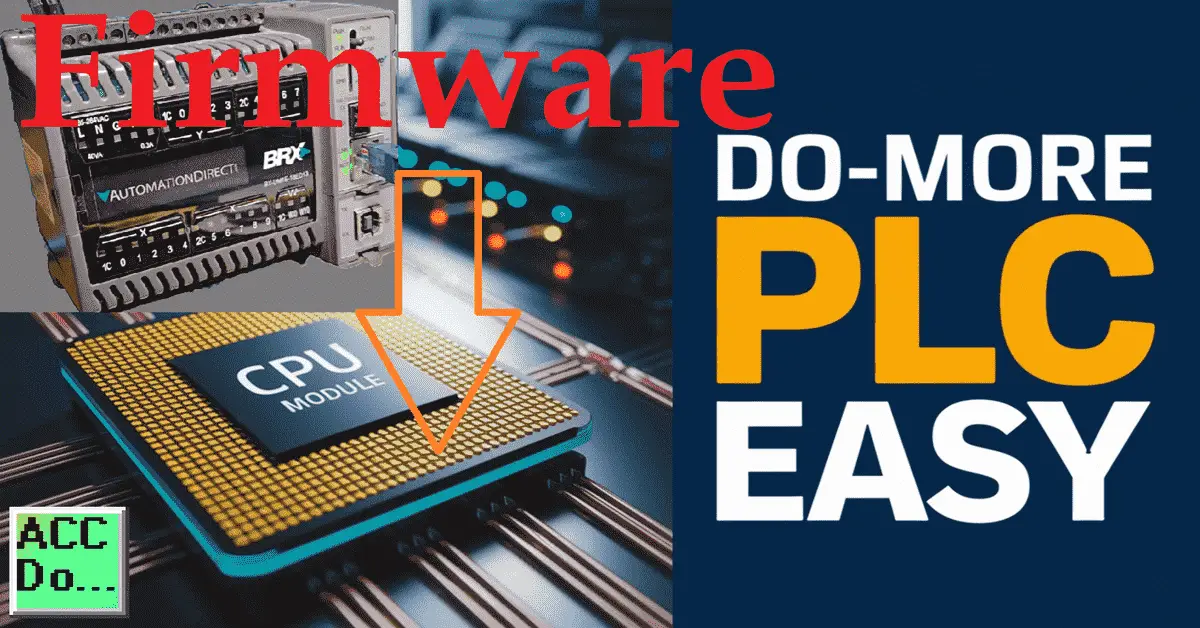Learn how to update your BRX Do-More PLC firmware with ease! We’ll walk you through a step-by-step guide on updating your BRX Do-More PLC firmware. Firmware updates can improve PLC performance, add new features, and ensure compatibility with newer technologies and hardware.
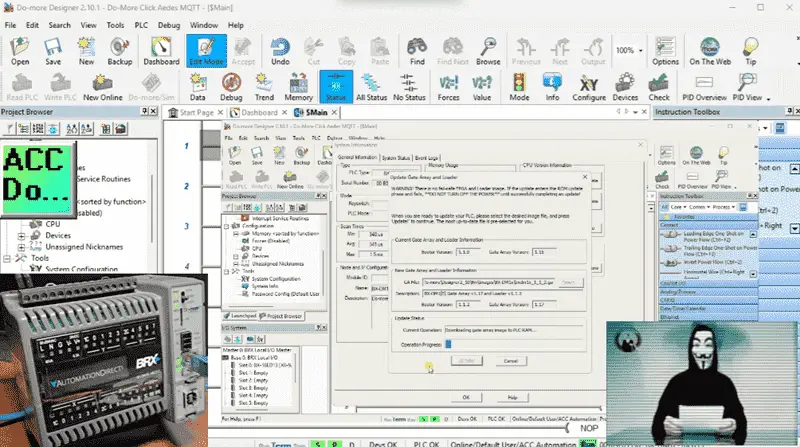
Remember that outdated firmware may leave your PLCs vulnerable to cyberattacks, including hacking and data breaches. Whether you’re a seasoned programmer or just starting, this information will help you confidently navigate the process. So, let’s get started and make updating your BRX Do-More PLC firmware a breeze!
Previously in this BRX series PLC, we have discussed:
System Hardware – Video
Unboxing – Video
Installing the Software – Video
Establishing Communication – Video
Firmware Update – Video
Numbering Systems and Addressing – Video
First Program – Video
Monitoring and Testing the Program – Video
Online Editing and Debug Mode – Video
Timers – Video
Counters – Video
High-Speed IO – Video
Compare Instructions – Video
Math Instructions – Video
Program Control – Video
Shifting Instructions – Video
Drum Instruction – Video
Serial Communication – Modbus RTU to Solo Process Temperature Controller – Video
Data Logging – Video
Email – Text SMS Messaging Gmail – Video
Secure Email Communication Video
AdvancedHMI Communication – Modbus TCP – Video
Analog IO – System Configuration – Video
HTTP JSON Instructions – Video
Analog Dusk to Dawn Program – Video
INC DEC 512 Registers for DMX512 – Video
PID with PWM Output – Video
PID Ramp Soak Profile – Video
Do-More Simulator MQTT Publish / Subscribe – Video
BRX Do-More PLC MQTT Communications – Video
Stride Field Remote IO Modules Modbus TCP Ethernet
– Unboxing SIO MB12CDR and SIO MB04ADS Video
– Powering and Configuring Video
BRX Do-More PLC to Stride Field IO Modbus TCP – Video
BRX Do-More PLC Ethernet Remote IO Controller BX-DMIO
– Unboxing BX-DMIO Video
– Configuration and Programming Video
Modbus RTU TCP Remote IO Controller BX-MBIO
– Hardware Video
– Powering and Configuring Video
BRX Do-More PLC to Modbus Remote IO Controller BX-MBIO – Video
Modbus ASCII Protocol – Video
Peerlink Ethernet Communication – Video
HTTP Web Server – Video
Dynamic Web Pages – Video
BRX Do-More PLC FTP Client Get Put – Video
Do-More Designer Element Browser – Video
BRX Do-More PLC High-Speed Input Counter – Video
BRX Do-More PLC High-Speed Input Timer – Video
BRX Do-More PLC High-Speed Input Pulse Catch – Video
BRX Do-More Simple Modbus Serial Communication – Video
BRX Do-More PLC Using Modbus IO Scanner Profile – Video
Our entire BRX Do-More series can be found here.
The programming software and manuals can be downloaded from the Automation Direct website free of charge. Watch the video below to see the firmware update on the BRX Do-More PLC.
Updating BRX Do-More PLC Firmware
We are currently connected to the BRX Do-More PLC through Ethernet. You can see this by the RUN indication and the status of the switch on the PLC.
Call up the “System Info” under the tools menu of the project browser. You can also use the main menu | PLC | System Information…
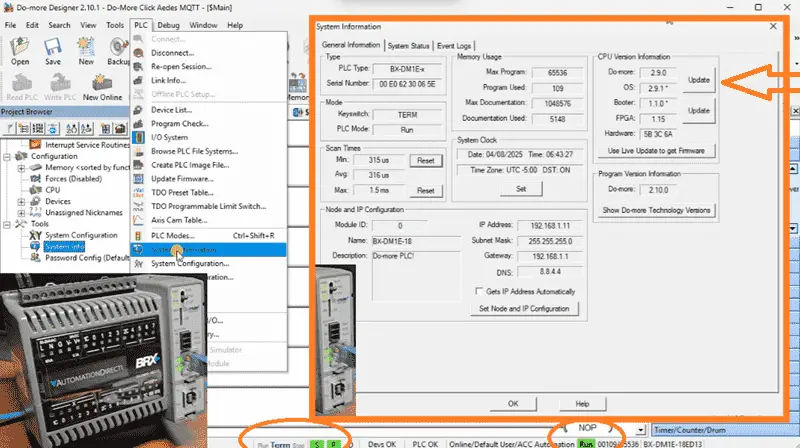
The System Information window will be displayed. Under the CPU Version Information, you will see the current firmware versions in the PLC. The asterisk indicates that an update is available. Select Update for the Do-more CPU version.
Watch the video below to see the BRX Do-More Firmware update.

A message will indicate that firmware updating can only happen in program mode. Since our switch is in terminal mode, the software can change this to program mode. Select Switch to PROGRAM Mode.
The Update Operating System window will be displayed. This will show us the current and new operating systems information. Select Update! An information window will ask us if we wish to continue updating our PLC’s operating system. Select OK.
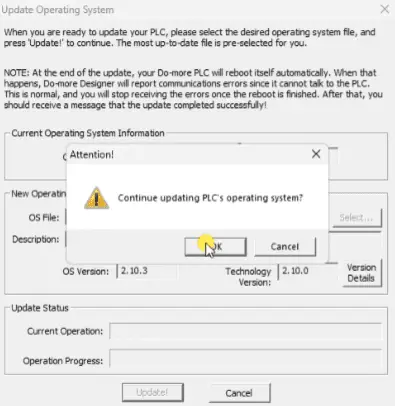
Our Update Operating System window will display the status of our firmware update. Firmware is software embedded explicitly in a hardware device to control its basic functions. In contrast, software is a broader term encompassing programs and data that run on a device and interact with the user. In a PLC, the firmware refers to programming, like starting the device, managing communication, and handling basic input/output. It is the scan of the PLC. Software is the higher-level programming, like ladder logic, that interacts with the user to define the logic and processes the PLC will execute.

When complete, the Update Operating System window will show that our current and new operating systems match. Select Exit. The software will then ask if we wish to switch back to RUN mode. Select Yes.
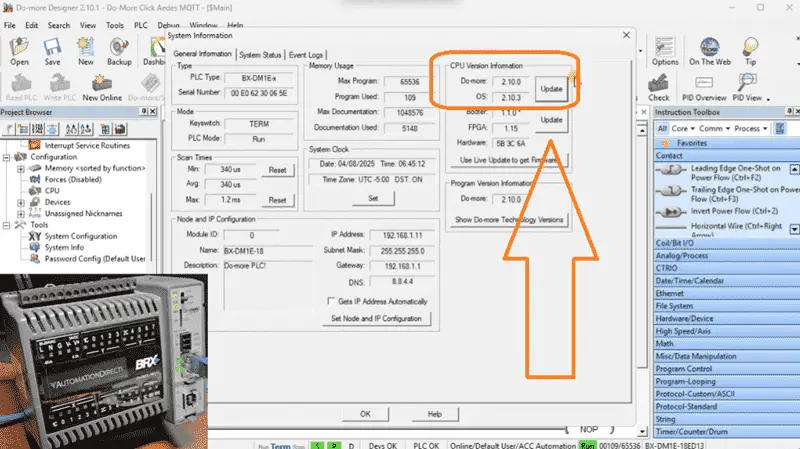
We can now see that the BRX Do-More PLC has been updated to the latest firmware version under the CPU Version Information in the System Information window.
BRX Booter Firmware Update
Once again, the asterisk indicates that the booter must also be updated. Select Update. A warning message window will again be displayed, asking if switching from RUN to PROGRAM mode is OK. Select Switch to PROGRAM Mode. Watch the video below to see the BRX Do-More Firmware update.

The Update Gate Array and Loader window will be displayed. This will show the current and new gate array and loader information. Select Update!
A window will now ask if we want to continue updating the PLC. Select OK.
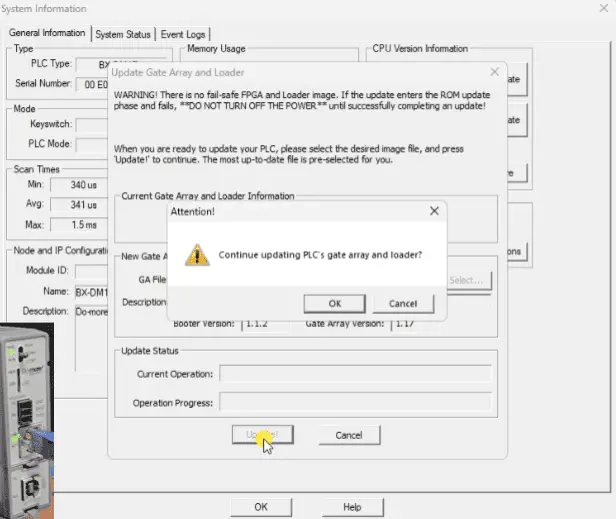
The Update Gate Array and Loader window will display the progress of our update. Booter is a short form for the boot loader in the PLC CPU. The FPGA is the Gate Array code in the PLC CPU. A gate array refers to logic gates that are pre-laid in matrix form on a chip, allowing for the realization of different types of logic gates by connecting the pre-laid components appropriately.
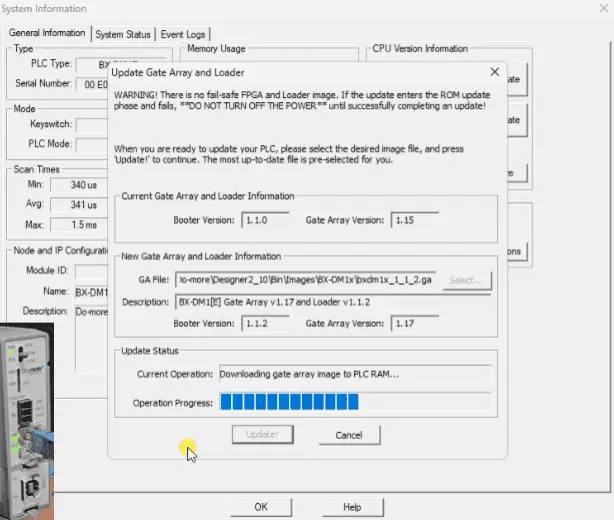
When the Booter firmware update is complete, a message will be displayed. We will need to power cycle the PLC to load the new image. Select OK to close the message. Select Exit to close the Update Gate Array and Loader window.
Answer Yes to return to RUN mode.

We can turn the power off and then turn on to our BRX Do-More PLC. Once communication is automatically established again, our CPU firmware version information is updated.
Select OK to close the System Information window.
Why Update PLC Firmware?
While the exact number of PLCs with outdated firmware is unknown, it’s clear that a substantial portion of PLCs in use, especially in older systems, are running older versions. Updating the firmware in a PLC (Programmable Logic Controller) is crucial for several reasons. First and foremost, firmware updates often include critical bug fixes, including security vulnerabilities and improvements that enhance the overall performance and reliability of the PLC. These updates can also introduce new features or functionality, allowing the system to adapt to evolving industry requirements or technologies.

The process of updating the BRX Do-More PLC firmware is quite simple. General PLC firmware updates typically involve downloading the new firmware version from the manufacturer’s website, connecting the PLC to a computer, and using the provided software to upload the update. Detailed instructions are often provided with the firmware, making it straightforward even for those with minimal technical experience. Keeping PLC firmware up to date is a best practice that contributes to the longevity and stability of industrial automation systems.
To learn more about the BRX Do-More PLC, click here. Click here to see how the Modbus Scanner in the BRX PLC makes it easy to communicate with other industrial equipment.
Our entire BRX Do-More series can be found here. The FAQ page for the BRX Do-More can be found here.
BRX Series PLC from Automation Direct – Power to deliver
Overview Link (Configure and purchase a system)
Manuals and Product Inserts (Installation and Setup Instructions)
Do-More Designer Software (Free Download Link) – The software will contain all of the instruction sets and help files for the BRX Series PLC.
Watch on YouTube: UPDATE Your BRX Do-More PLC Firmware Made EASY!
If you have any questions or need further information, please contact me.
Thank you,
Garry
If you’re like most of my readers, you’re committed to learning about technology. Numbering systems used in PLCs are not challenging to learn and understand. We will walk through the numbering systems used in PLCs. This includes Bits, Decimal, Hexadecimal, ASCII, and Floating Point. To get this free article, subscribe to my free email newsletter.
Use the information to inform others how numbering systems work. Sign up now.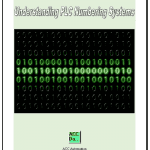 The ‘Robust Data Logging for Free’ eBook is also available for free download. The link is included when you subscribe to ACC Automation.
The ‘Robust Data Logging for Free’ eBook is also available for free download. The link is included when you subscribe to ACC Automation.

